The Image of Government in Iranian Fictions, 1921-1941
Between the coup in February 1921 and the occupation of Iran by the Allied Powers which ultimately put an end to Reza Shah Pahlavi’s reign (1925-1941), a series of political and social events occurred that led to the rise of the absolutist state in the country. The emerging form of governance was based on an image of government that influenced the discourse among various political groups and movements, including nationalists, leftists, Islamists and monarchists, and also reflected the people’s everyday life certainties. In this paper, the main research questions are as follows: 1. Was the specific image of government rooted in the worldview of the time and the everyday life certainties of the ordinary people? 2. What important factors in various fields had shaped the image of government? 3. To what extent was this image of government resonated in the fictional books in literature of this period?In the hypothesis, it is asserted that Iran’s modern government in the first Pahlavi period had been formed on the basis of an image which can be found in the most important Iranian novels of the period, and is rooted in the certainties of the daily lives of the Iranian people, and created dichotomies such as authoritarianism/ democracy in the various aspects of life. Using the method of explaining typical characters in György Lukács’ sociology of novel as well as the theoretical framework of Mannheim’s sociology of knowledge, the authors study and explain Iranian expectations and views of government during 1921-1941 period as indicated in the social novels and stories. As in other fields of art, fiction books reflect the socio-political ideals of the authors and inevitably manifest the existing realities, and circumstances of the society, including each country and region to which they belong. As a consequence, the outstanding works of a certain era reflect the authors’ own ideas about the prevailing situation, criticism of the disorder and malfunctions, and suggestions for change and reforms Furthermore, the authors’ description of imaginary events or re-narrating real events, characterization and typification, and even description of people's everyday lifestyles in a given time period, reveal their realistic views. According to György Lukács account of the decline of aristocracy in Balzac’s, despite Balzac's personal attachment to this class, he accurately and possibly unintentionally revealed how the emerging bourgeoisie was gradually seizing socio-economic and political power and marginalizing the aristocrats. Similarly, borrowing from Mannheim in Ideology and Utopia, we see two different aspects, the ideological aspect and the utopian aspect, in the top fiction books written between 1921-1941 during the reign of Reza Shah. The former refers to the realistic nature of the stories and the latter to their critical-idealistic feature which reflects the author's specific thoughts and worldview. We hypothesized that the fiction books in literature of this period in both ideological and utopian aspects, have specific worldviews in relation to the image of government in various domains such as domestic, foreign, economic and cultural policies. This was in part proposed by Davood Feirahi. Among the authors whose works have been examined are Morteza Mushfeq Kazemi, Mohammad Ali Jamalzadeh, Mohammad Massoud, Sadegh Hedayat, Mohammad Hejazi and Bozorg Alavi. They are among the influential thinkers of their time and remain familiar names for Iranian readers. In addition, we studied the available critiques which evaluate the key ideas and interpret the authors’ intentions, and discuss the weaknesses of the works by providing supporting evidence. The interpretations of the authors’ specific narratives, especially the works of Abdul Ali Dastghib was examined in order to better understand these written accounts of the past. The content analysis of these fictions helps to analyze and decipher some hidden aspects of factors in various areas such as domestic politics, foreign policy, economic policy, cultural policy (worldview) which affected the formation and reformation of government. This will in turn help us to understand the advent of dichotomies such as authoritarianism/ democracy, independence/ dependence, public interest/ private ownership, and finally value-normative duality and friction in government and politics of the time. Although these dichotomies initially appeared in this time period, they remained a permanet fixture in the debates in the currents of thought in Iranian political circles. Consequently, the analysis of their roots is very important in better understanding the clashes of ideas and worldviews in Iranian society today and even predicting the probable future developments.
- حق عضویت دریافتی صرف حمایت از نشریات عضو و نگهداری، تکمیل و توسعه مگیران میشود.
- پرداخت حق اشتراک و دانلود مقالات اجازه بازنشر آن در سایر رسانههای چاپی و دیجیتال را به کاربر نمیدهد.



